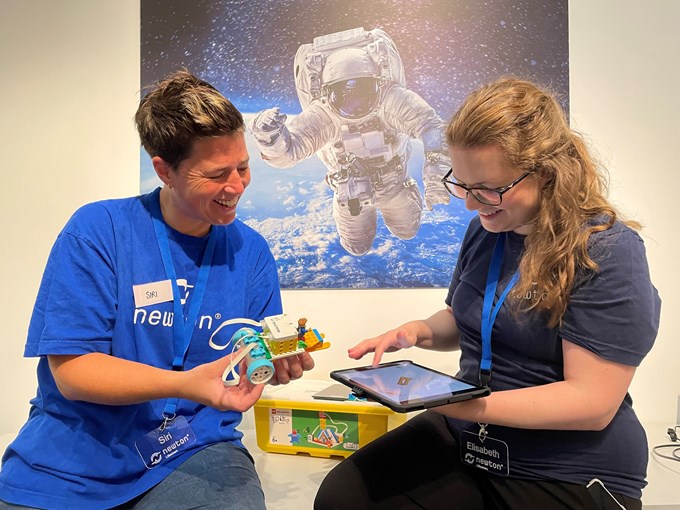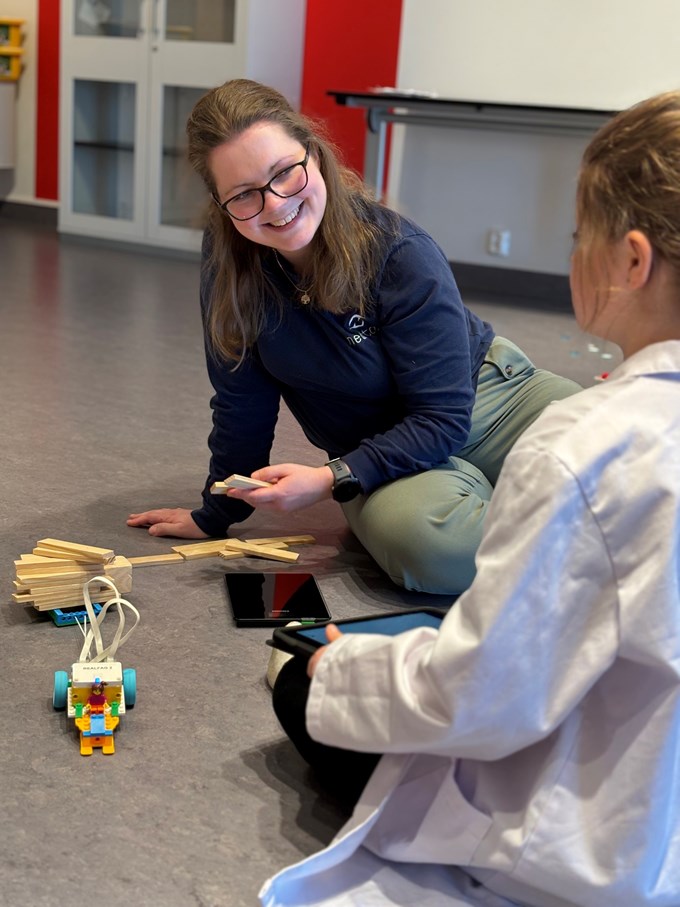Meet the Newton Teacher of the Month, Elisabeth from Newton Lillestrøm in Norway. She believes teachers can gain a lot from visiting a Newton Room.
Name: Elisabeth Marie Schou Sandve-Johansen
Age: 35
Location: Lillestrøm, Akershus
Has been a part of Newton since: 2023
Professional Background: Graduated from Oslo MET as part of the last cohort of general teacher education students, specialising in science and mathematics for primary and lower secondary levels.
Life Outside of Work: Married, living with her husband, their 2-year-old child, and a 5-year-old black Labrador.
“What sparked your interest in STEM (Science, Technology, Engineering, Math) in the first place?”
“A dad who often took me out into nature, showing me the importance of caring for it. He also worked as a plumber. He always showed interest in what I was learning at school, and if it were related to his trade, he would dig up all the information he could to supplement what we were being taught. I remember having a huge collection of pamphlets and brochures about heat pumps for a project. If there were topics he wasn’t familiar with, he would sit down and read up on them so we could discuss them together.
I also had a teacher who almost always included a question on tests about something we hadn’t directly learned. In those tasks, we had to use what we had learned within the subject to try and find a solution. I remember finding it exciting because it allowed us to apply our knowledge and come up with ideas about how things were connected.
“What do you love most about working in a Newton Room?”
"I love working with the subjects I’m passionate about. It’s rewarding to meet a wide range of students and teachers, and incredibly educational to have all the municipality's primary and lower secondary schools visit. I learn something new with every visit, from both the students and the teachers. One of the most exciting aspects is the opportunity to fine-tune how I teach the modules over time. Adjusting my approach for different groups of students is both challenging and highly educational."
“What’s your favourite topic or module to teach, and why?”
"I find most things fun to teach, but if I had to choose, it would be hands-on skills related to science and math that students rarely encounter elsewhere. I also enjoy supporting students as they test hypotheses and explore creative ideas. It’s amazing to involve them in figuring out how something works — or seeing the result when they don’t know what to expect — and showing them how fun STEM can be."
“What do you hope students and teachers take away from their visit to your Newton Room?”
"I hope students see how useful STEM subjects can be in everyday life and as adults. Of course, I’d love for them to develop a deeper interest in the topics or methods we cover — and for some to envision a future career in STEM, beyond the typical lab coat and safety goggles stereotype.”
“I also hope teachers leave inspired to try something new in their classrooms. I want them to pick up ideas during the visit they can use in class discussions and beyond the planned follow-up work. A visit to Newton is also a great chance for teachers to observe individual students and their groups in a different setting. Maybe there’s a budding scientist who doesn’t shine in traditional lessons."

GOOD COLLEAGUES. Elisabeth, together with Newton teacher Siri, is programming a SPIKE Prime robot. Photo: Linda Smedbakken.
“Can you share a fun or inspiring story that’s happened in your Newton Room?”
"We’ve had several visits from students who usually struggle to participate in regular school activities. At Newton, they often become actively engaged for large parts — or even the entirety — of the visit. That always feels incredibly rewarding."
“How can we best inspire children and young people to pursue STEM education and careers?”
"Research shows that it’s important to reach students at a young age — before gender stereotypes and socio-economic factors limit their perception of what's possible in terms of interests, hobbies, school subjects, and eventually, career choices.
I believe Newton needs even more modules designed for younger students. In Norway, that means giving STEM subjects more focus from the very beginning, and that kindergartens and primary schools should use hands-on activities to spark interest in science and math.
For older students, it’s key to showcase the wide range of STEM-related careers available. You don’t have to work in a lab! You could design models, develop apps and support systems, conduct field research, or make environmental observations. There are countless ways to work with STEM, and it’s crucial to show older students the diversity of options before they make choices that impact their education and career paths.
We also shouldn’t forget the educational value that good STEM teaching can bring to students' overall development."
“ If you could meet one famous scientist, past or present, who would it be and why?”
“Marie Curie. It would have been fascinating to hear how she planned her research and adjusted along the way as she made observations. I would have loved to know how she experienced being a female scientist in her time—whether there were things that prevented her from advancing as far as she wanted in her work. And I would have given her a tip to protect herself better so she could have lived longer. Who knows what breakthroughs that might have led to?”
And two people who aren’t strictly scientists but have done (and are doing) an incredible job in science communication: David Attenborough and Michael Mosley. I would love to learn a few tricks from them, given how engaging and captivating they have been (and still are) as communicators.”
"What are three things on your bucket list?"
-
A guided tour of the Natural History Museum in London with David Attenborough.
-
Visit New Zealand and see the filming locations from The Lord of the Rings.
-
Participate in volunteer work focused on animal conservation and welfare.

DREAM JOB. Elisabeth believes she has the dream job as a Newton Teacher.
Newton Lillestrøm
- Newton Lillestrøm in Norway is located in a large municipality with 28 primary and lower secondary schools, serving over 11,000 students.
- Throughout the school year, they offer programs to all the municipality's 2nd, 6th, and 9th graders.
- The Newton room is adjacent to the municipality's newest school building, Sophie Radich Lower Secondary School, centrally located in Lillestrøm.
- They have two Newton rooms with a dedicated laboratory in the middle and share facilities with the Lillestrøm Realfagssenter.
- Besides offering Newton modules, they help organise the FIRST LEGO League final for the municipality's 3rd graders and host the Girl Tech Fest, along with courses for teachers and after-school staff.